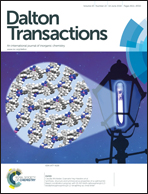A simple BODIPY-aniline-based fluorescent chemosensor as multiple logic operations for the detection of pH and CO2 gas†
Abstract
A simple 4-aniline boron-dipyrromethene (BODIPY) dye (1) was developed as a highly sensitive acidic pH fluorescent probe excitable with visible light based on a photoinduced electron transfer (PeT) mechanism. The pH titration indicates that the fluorescence intensity increases more than 500-fold within the pH range of 4.12–1.42 with a pKa value of 3.24 in methanol–water (1 : 1, v/v) solution, which is valuable for studying strongly acidic conditions. Density functional theory (DFT) calculations reproduce the fluorescence off–on behavior. 1 has also been used as a fluorescent chemosensor for the visual detection of dissolved carbon dioxide (CO2) gas. The underlying mechanism of the sensing process is rationalized. This probe can be recovered by bubbling nitrogen (N2) gas into CO2-treated solutions for over 10 cycles. In addition, two logic gates (OR and INH) have been achieved at the molecular level by changing the initial states of system 1 and chemical inputs.


 Please wait while we load your content...
Please wait while we load your content...